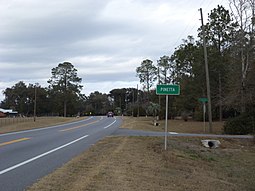Madison County, Florida
[4] It was developed as part of the plantation belt, with cotton cultivated and processed by enslaved African Americans.
[5] In the period after Reconstruction, racial violence rose in the state, reaching a peak at the end of the 19th century and extending into the difficult economic years of the 1920s and 1930s.
[5] The last known lynching in the county was that in October 1945 of Jesse James Payne, a young married sharecropper with a child.
The sheriff and other law enforcement officials appeared implicated in Payne's murder, as he was left in the county jail unguarded after mob action had been threatened.
The case received national attention and the governor was strongly criticized for failure to mount a true investigation or to take action against the sheriff.
[5] In 1949, Ernest Thomas, a WWII veteran, was tracked to a swamp in Madison County after he had fled from a wrongful accusation of rape in Groveland, Florida.
He was found sleeping under a tree and was shot an estimated 400 times by a lynch mob led by Lake County Sheriff Willis V.
[7] As of August 2012, Madison became a wet county, meaning that voters had approved the legal sale, possession, or distribution of alcoholic beverages.
The other line is owned by the Georgia and Florida Railway, and runs in close proximity to US 221 throughout Madison County.
The small town of Greenville was the childhood home of rhythm and blues giant Ray Charles.



